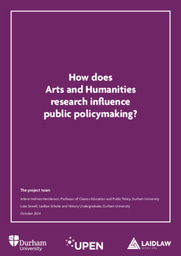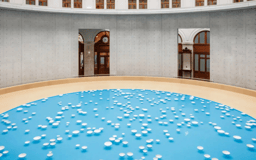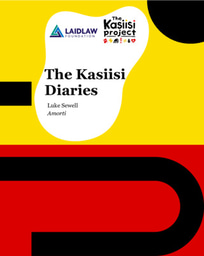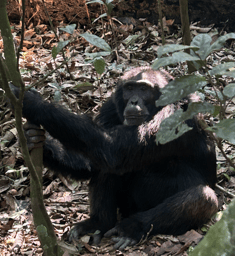Research Paper

How does Arts and Humanities research influence public policymaking?
The Arts and Humanities are invaluable to the policymaking world, as my and Professor Arlene Holmes-Henderson’s research project aimed to demonstrate. Our project involved collaborating with dozens of Arts and Humanities academics across a diverse range of universities to find case studies of recent, successful examples of Arts and Humanities research influencing policy. We then processed and organised these responses to create a brochure showcasing participants’ experiences. This brochure will be shared on the UPEN (University Policy Engagement Network) website and circulated amongst academic communities. We hope our output will augment the broader literature around this topic (such as those produced by UPEN and the Institute for Government) and will facilitate further research-policy collaboration.
The need for our project is urgent; the Arts and Humanities have faced significant reputational disruption over the past couple of decades. Many journalists and politicians have painted a negative picture of the Arts and Humanities as being ‘mickey mouse’ fields, denoting a lack of value to graduates in their futures, as well as being not relevant to the needs of society. As our research shows, this could not be further from the truth, not least in the policymaking world. Civil servants, government officials and policymakers have formed very productive relationships with academics in the Arts and Humanities to gain advice on how to formulate policy. Showcasing this in a brochure and circulating it amongst academic and policymaking groups, therefore, will be very beneficial to both communities.
To conduct our project, we first gained ethical approval. The main priority in doing this included making sure our procedures for data handling were compliant with Durham University’s data protection policy. Once this was obtained, we created a Microsoft Form with 11 questions to gain the appropriate information and consent from participants. Our list of participants was drawn from Professor Holmes-Henderson's network of contacts; academics who had previously expressed interest in sharing their experiences regarding research-policy collaboration. Our survey was further circulated in the UPEN newsletter, whilst colleagues at the University of Lancaster also disseminated the link. By the time of sending our case studies to be typeset, we had 34 responses. These were formatted into a Microsoft Word document which was used by our graphic designer, Rebecca McLoughlin, for typesetting.
During the time between circulating the Microsoft Form and sending case studies off for typesetting, we made key decisions about how we would process case studies:
- Most, if not all, case studies required light editing and formatting so they would be suitable for our brochure. This was done by Luke and Arlene in partnership.
- Some responses were more geared towards Social Science research-policy engagement rather than that of Arts and Humanities. These responses were separated, and we decided that they could be used for a different project.
- Some case studies required greater elaboration on certain aspects of responses or web links to publications. When this was the case, we reached out to our respondents and requested this.
- Although we knew the academic titles of our respondents, we weren’t sure how this ‘mapped’ where they were in their career level. This was a potentially enticing thing to denote in the brochure, as academic readers interested in collaborating with policymakers may use this information to think about the case studies in terms of their own career stage. However, upon further consideration, we thought this may prove problematic for the respondents and lead to over-simplification of the complexities of academic careers.
- We knew that to make our brochure useful to readers, we would need to feature illustrations of research-policy engagement and photographs of our respondents. We made sure to include these as part of each case study before they were sent off for typesetting. Including additional images was more problematic than we first thought. Durham University’s account for stock images proved too expensive for our budget and UPEN’s collection of images was not as extensive as we had hoped. We had to trawl the internet for copyright-free creative commons-licensed images instead. This was time-consuming and limiting.
Besides the processed case studies, we worked on incorporating an introduction and afterword to bookend the brochure and set the case studies in their contexts. The introduction was written by us and discusses the background to Arts and Humanities research-policy collaboration and broad patterns in the case studies. Regarding the afterword, we decided it would be especially useful to have it written by colleagues at UPEN, namely Laura Bea, Marina Altoe and Rebecca di Corpo who are Co-Chairs of UPEN Arts and Humanities Sub-Committee. They kindly drafted the afterword, which discusses the value of research-policy engagement and the relevance of the case studies to this.
Again, the nature of our case studies reflects the vibrant diversity of Arts and Humanities research-policy engagement. The case studies were divisible into four different types which broadly correspond with UPEN’s categorisations of government: National Government, UK Parliament & Devolved Administrations, Local Authorities, and other policymaking bodies such as NGOs. We split our brochure into four parts accordingly, with a relatively similar number of case studies in each segment. This would be useful to academic or policymaker readers whose potential/actual collaboration is in one of those sectors. There were elements of overlap in the case studies, however, namely between case studies concerned with national government as well as local authorities. Where this was the case, it was noted in the table of contents.
Regarding the actual questions and feedback from respondents, we asked them to summarise in roughly 150 words:
- The research they shared with policy officials; this was ideally in the format of a bibliography-style entry. If this were not available, links to relevant websites were provided.
- The beginnings of their research-policy interaction; in other words, how the academic came to start working with a policymaker in using their research to shape policy.
- The collaboration involved in research-policy interaction; this allowed respondents to discuss the lines of work they involved themselves in with the policymaker.
- The impact of their research-policy interaction; key to our project’s title question, this field gave respondents the opportunity to show how their research translated into effective policies.
- The challenges they faced in research-policy interaction; this gave respondents the opportunity to highlight the problems they encountered during their policy engagement encounter(s).
- The advice they would give to other academics; formatted into numbered points of advice, respondents provided top tips for colleagues based on their experiences.
These questions gave a broad picture of the experiences between academics and policymakers. Generally, most respondents were able to provide a good yet concise amount of detail in their answers. Again, where needed, we followed up respondents for further input if we felt the brochure would benefit.
There were some intriguing commonalities in the responses even given their diversity. For example, in the ‘advice’ section, many respondents noted the importance of setting expectations with policymaking colleagues from the beginning of their collaboration. This perhaps suggests that there is a mismatch between what the policymaker thinks the academic may contribute, and what they're able to offer. This excerpt from the introduction of the brochure may offer further insight into this advice: ‘Arts and Humanities research is especially good for helping map complex human questions for which there are no definitive solutions. Equally, policymakers should be advised of how this may limit researchers' abilities to supply policymaking colleagues with information that points clearly to a course of action.’ Of course, each academics’ experience varies, and some respondents did not suggest similar advice. However, the broad patterns in advice offered by academics allows readers to gain a rough idea of how to plan their own research-policy interaction. Not only this, but they can contact respondents whose experiences are showcased for further elaboration and advice. This gives our brochure an element of real-world application which other guides to research-policy collaboration don’t feature.
The above is just one example of the significant commonalities in advice offered by academics, but there were also commonalities in the issues they faced in their collaboration. Some respondents discussed politics as an issue, both owing to the nature of election cycles (one of which occurred during the time of the responses’ collection), as well as political interests becoming an obstacle in collaboration. Other respondents noted more practical issues, such as the differences in the pace of work of the civil service compared to academia, or securing funding to secure the longevity of projects. As noted in the introduction to the brochure, we believe that these issues call for further research into how Arts and Humanities academics may overcome the challenges they encounter in their collaboration with policymakers.
To focus specifically on three different Arts and Humanities case studies might be helpful to demonstrate their diversity and what makes them unique to the academic and policymaking worlds:
- Dominic Lees’ experiences of being consulted by parliamentarians regarding filmmaking illustrates the usefulness of academic Arts expertise to the UK’s committee-based policymaking process. Lees supplied us with two publications and a link to other publications he’d shared with policymakers, and explained his interactions with the House of Lords as well as Commons committees regarding his findings. Lees attributed to this collaboration the then chancellor’s ‘Independent Tax Credit’ for small British filmmakers. This case study is revealing of how direct consultation by policymakers at the top level may translate to action which benefits the very people whom an academic researches.
- Sam Johnson-Schlee’s case study serves as a second example of how Humanities research may be applied to ‘real-world’ policymaking scenarios. Johnson-Schlee, a historian of heating and energy, was consulted by the Greater London Authority regarding the best direction to take in promoting their ‘Warmer Homes’ retrofit programme. This followed recognition of his projects by a policymaker during Johnson-Schlee’s time working on a British Academy Innovation fellowship. Their collaboration led to the GLA pivoting towards promoting housing retrofitting as something done to benefit the wider community and environment, and less as something done to benefit the homeowner's finances. According to Johnson-Schlee’s research on the culture of heating and energy, this approach is more effective in uptake of such heating systems. Compared to the previous case study, this interaction shows how academics can influence those in local government in formulating regional initiatives.
- Genevieve Lively’s case study explores how Humanities academics may work with the UK civil service to shape their methodology. Lively, a classicist, has been involved with several government departments in developing their cybersecurity initiatives using methods from her field including Futures Studies, Narratology and Anticipation. Part of the goal of her collaboration with government departments, as well as the Cabinet Office, was to create a framework for identifying risks to cybersecurity. In turn, the NCSC (National Cyber Security Centre)’s strategy on risk management was shaped to account for Futures scenario planning. Lively’s experience stands out as significant especially in the context of her advice regarding the civil service: ‘Civil servants - especially the adept ones - tend to move roles and departments swiftly, so capture evidence/letters of support regularly’.
These case studies are just three of twenty-one which showcase unique and striking collaboration between Arts and Humanities academics and policymakers. However, they also capture neatly the diversity of levels of government and the nature of said collaboration.
Regarding how the project has impacted my research skills and competencies, the table below denotes secure points to those which I’d like to develop.
|
Secure Points |
Development Points |
|
This project involved extensive collaboration with Arlene, respondents to the survey, our graphic designer, colleagues in UPEN as well as Durham University. I was quite pleased with how I was able to navigate workloads and deadlines with others. |
Going forward, I’ve identified that, for me, it is best to be more autonomous and give updates on my progress to colleagues, rather than querying an approach and waiting for a response before acting. |
|
I found using Microsoft Forms to facilitate our questionnaire was very reliable. |
There were a few technical issues which I’ll be more mindful of in the future. This included ensuring that I grant access to documents to others collaborating on the project, and ensuring I copy in all relevant parties in e-mail correspondence. |
|
I was very pleased we had Becky, our graphic designer, on the team and thought the brochure template she produced was exactly the style we were looking for. I recognised my own graphic design skills wouldn’t be developed enough for this task early on. |
As previously mentioned, finding the right images to include in our brochure proved to be problematic. Namely, we invested a considerable degree of time in trying to access the university’s iStock images only to find they would be too expensive. This may have been avoided if we’d perhaps asked respondents to attach images relevant to their research in our survey. |
|
I was pleased to include responses from my own professors who I was aware had experiences in research-policy collaboration previously (I.e. using my own research network). |
|
The biggest takeaway of this project for me is that I’ve gained significant insights into the academic and policymaking world. As someone who is deeply interested in politics, the civil service and government, being able to collaborate with people who have worked with policymakers has been a very interesting experience. I’m looking forward to sharing my findings with others in my own academic circles as well as on the Laidlaw programme. Furthermore, I shall be attending an APPG for policymakers who studied humanities subjects off the basis of this project. I believe this project will be an excellent segue for me to get increasingly involved in the policymaking and academic world, therefore.
To conclude, Arts and Humanities research has influenced public policymaking in significant and diverse ways. At a time where there is doubt as to whether Arts and Humanities teaching and funding offers ‘value for money’, it is imperative that we shift the conversation to highlight the nuanced and valuable ways in which the Arts and Humanities contribute to society. We hope that our publication and its dissemination will raise awareness of this. Furthermore, it will be of direct benefit to those in academic and policymaking circles who wish to learn more about how to better collaborate between those fields.
18/09/2024





Please sign in
If you are a registered user on Laidlaw Scholars Network, please sign in
Amazing research, Luke! It's so important to remember the value of arts and humanities studies and the real world impact these fields often have on shaping policy!